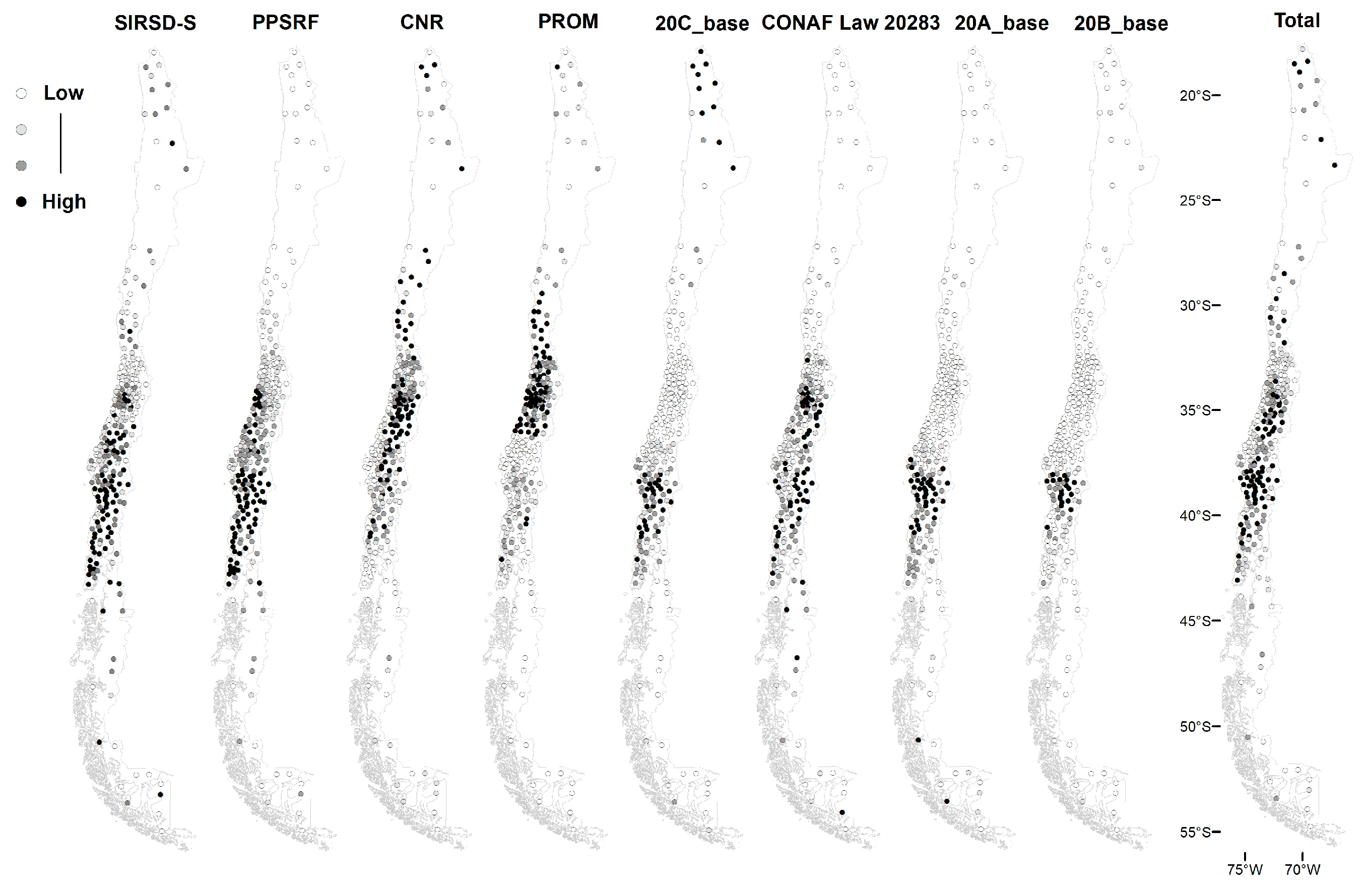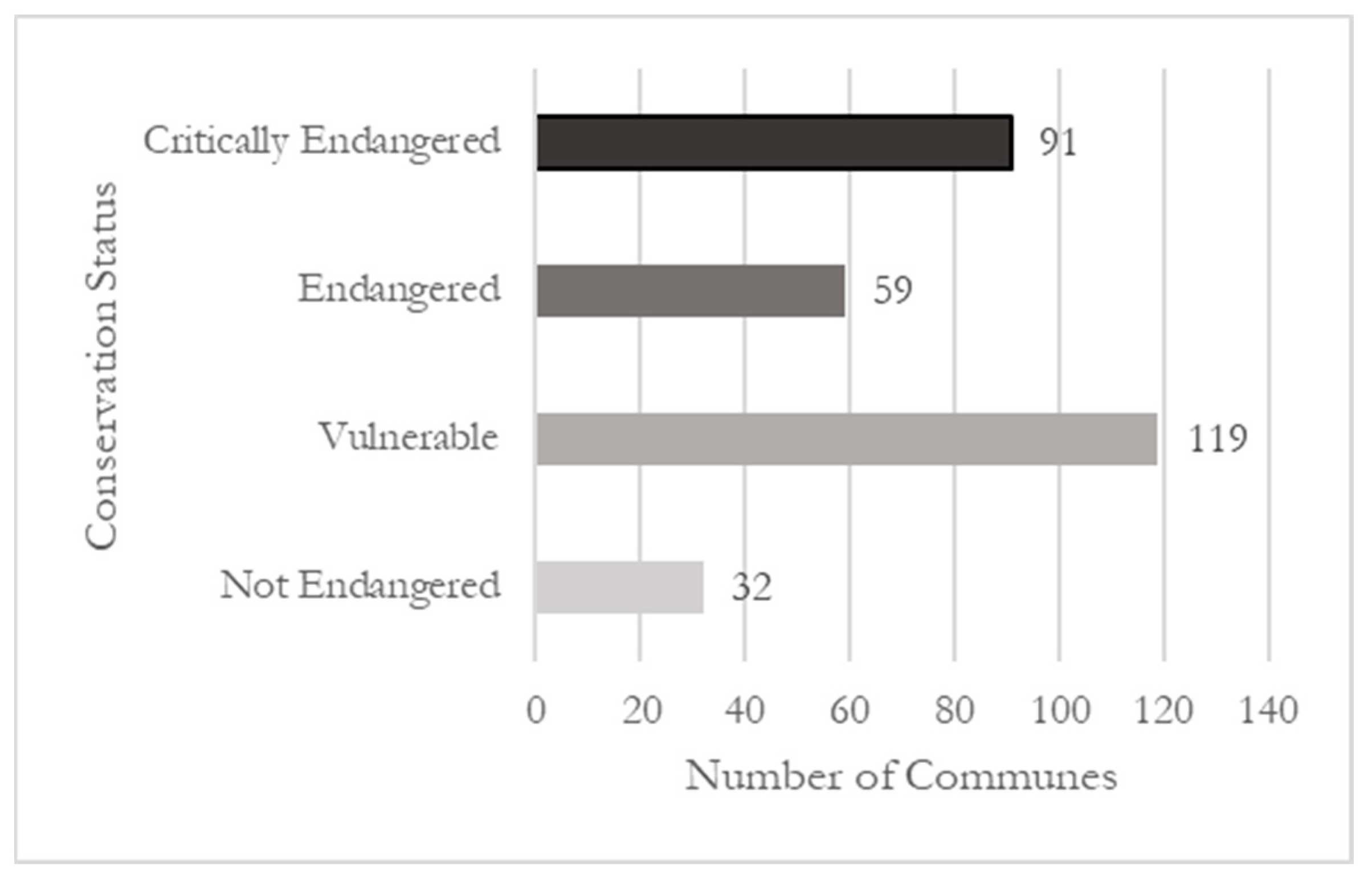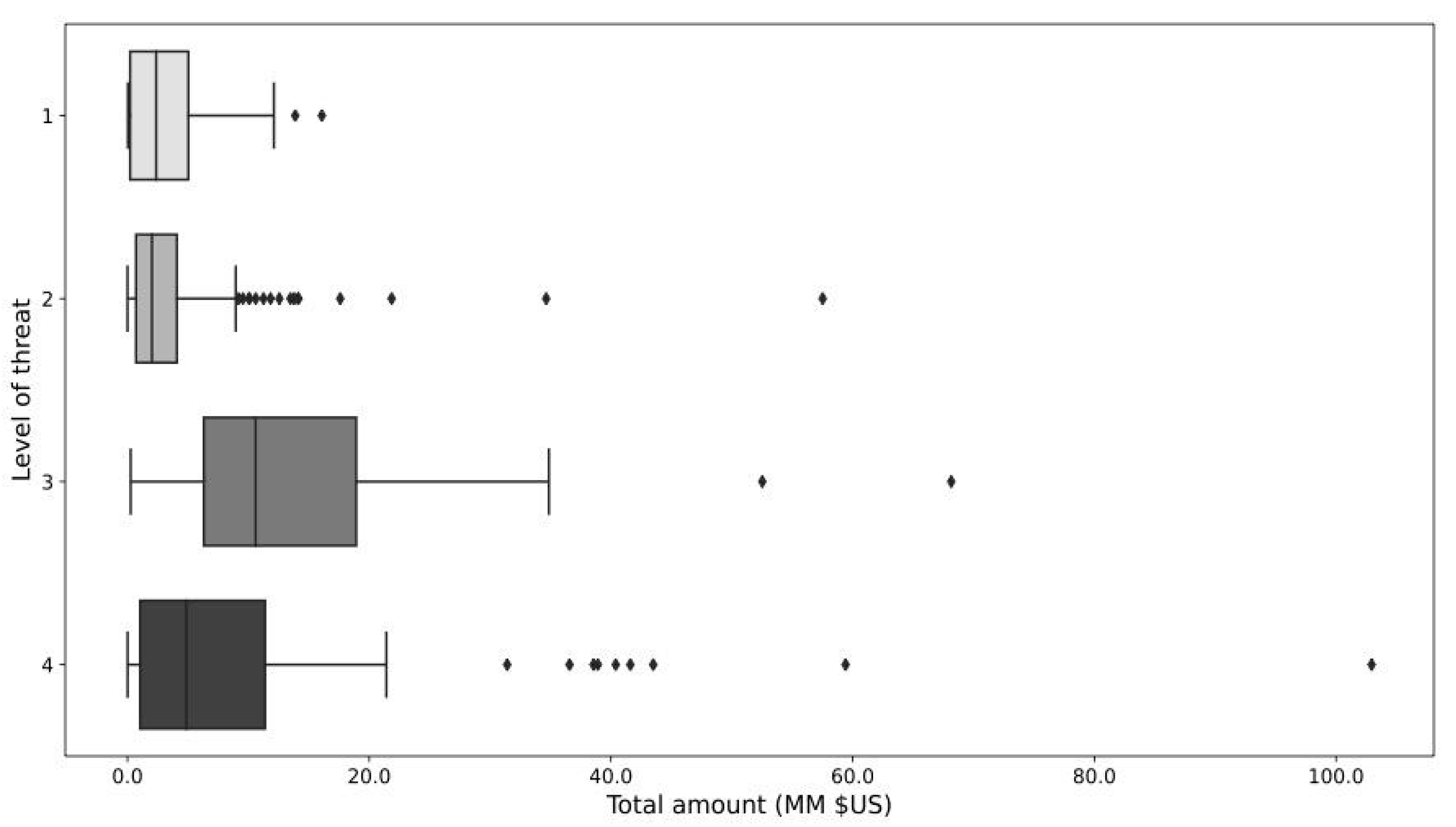Are We Putting the Money in the Right Pocket? Ascertaining the Eventual Relationship between Silvoagricultural Subsidies, Ecosystem Threats, and Ecosystem Services in Chile
Abstract
1. Introduction
2. Materials and Methods
3. Results
3.1. IPP-FFWs Allocation at the Commune Level in Chile
3.2. Threats at the Commune Level
3.3. Land-Use Change in the Biobio Region
4. Discussion
Supplementary Materials
Author Contributions
Funding
Data Availability Statement
Acknowledgments
Conflicts of Interest
References
- Bellmann, C. Subsidies and Sustainable Agriculture: Mapping the Policy Landscape; Chatham House: London, UK, 2019. [Google Scholar]
- Garrone, M.; Emmers, D.; Lee, H.; Olper, A.; Swinnen, J. Subsidies and agricultural productivity in the EU. Agric. Econ. 2019, 50, 803–817. [Google Scholar] [CrossRef]
- Atanasov, D.; Lubeniqi, G. Subsidies in agriculture and their influence on sustainability. Theory and methodology. Agric. Sci./Agrar. Nauk. 2019, 11, 29–34. [Google Scholar]
- Kaur, R.; Sharma, M. Agricultural Subsidies in India Boon or Curse. IOSR J. Humanit. Soc. Sci. 2012, 2, 40–46. [Google Scholar] [CrossRef]
- Merckx, T.; Pereira, H.M. Reshaping agri-environmental subsidies: From marginal farming to large-scale rewilding. Basic Appl. Ecol. 2015, 16, 95–103. [Google Scholar] [CrossRef]
- Organization for Economic Cooperation and Development, OECD. Agricultural Policy Monitoring and Evaluation 2021: Addressing the Challenges Facing Food Systems; OECD Publishing: Paris, France, 2021. [Google Scholar] [CrossRef]
- Barbier, E.B. The Policy Implications of the Dasgupta Review: Land Use Change and Biodiversity. Environ. Resour. Econ. 2022, 83, 911–935. [Google Scholar] [CrossRef]
- Oficina de Estudios y Políticas Agrarias, Odepa. Estadísticas Económicas; Oficina de Estudios y Políticas Agrarias: Santiago, Chile, 2022; Available online: https://www.odepa.gob.cl/estadisticas-del-sector/estadisticas-economicas (accessed on 10 January 2022).
- Oficina de Estudios y Políticas Agrarias, Odepa. Panorama de la Agricultura Chilena, Ministerio de Agricultura, Chile. 2019. Available online: https://www.odepa.gob.cl/wp-content/uploads/2019/09/panorama2019Final.pdf (accessed on 10 January 2022).
- Pérez, C.; Simonetti, J. Subsidy Accountability and Biodiversity Loss Drivers: Following the Money in the Chilean Silvoagricultural sector. Sustainability 2022, 14, 15411. [Google Scholar] [CrossRef]
- Ministerio del Medio Ambiente. Quinto Informe Nacional de Biodiversidad de Chile ante el Convenio sobre la Diversidad Biológica (CBD); Ministerio del Medio Ambiente: Santiago, Chile, 2014; 140p. [Google Scholar]
- Ministerio del Medio Ambiente. Sexto Informe Nacional de Biodiversidad de Chile ante el Convenio sobre la Diversidad Biológica (CDB); Ministerio del Medio Ambiente: Santiago, Chile, 2019; 220p. [Google Scholar]
- Comisión Económica para América Latina y el Caribe. Cepal/Organización para la Cooperación y el Desarrollo Económicos–OCDE. Evaluaciones del desempeño ambiental; Comisión Económica para América Latina y el Caribe: Santiago, Chile, 2016. [Google Scholar]
- Hermosilla-Palma, K.; Pliscoff, P.; Folchi, M. Sixty years of land-use and land-cover change dynamics in a global biodiversity hotspot under threat from global change. J. Land Use Sci. 2021, 16, 467–478. [Google Scholar] [CrossRef]
- Armesto, J.J.; Manuschevich, D.; Mora, A.; Smith-Ramirez, C.; Rozzi, R.; Abarzúa, A.M.; Marquet, P.A. From the Holocene to the Anthropocene: A historical framework for land cover change in southwestern South America in the past 15,000 years. Land Use Policy 2010, 27, 148–160. [Google Scholar] [CrossRef]
- Pliscoff, P. Aplicación de los criterios de la Unión Internacional para la Conservación de la Naturaleza (IUCN) para la evaluación de riesgo de los ecosistemas terrestres de Chile. Informe Técnico; Ministerio del Medio Ambiente: Santiago, Chile, 2015; 63p. [Google Scholar]
- Hasan, S.S.; Zhen, L.; Miah, M.G.; Ahamed, T.; Samie, A. Impact of land use change on ecosystem services: A review. Environ. Dev. 2020, 34, 100527. [Google Scholar] [CrossRef]
- Zheng, H.; Peng, J.; Qiu, S.; Xu, Z.; Zhou, F.; Xia, P.; Adalibieke, W. Distinguishing the impacts of land use change in intensity and type on ecosystem services trade-offs. J. Environ. Manag. 2022, 316, 115206. [Google Scholar] [CrossRef]
- Bryan, B.A. Incentives, land use, and ecosystem services: Synthesizing complex linkages. Environ. Sci. Policy 2013, 27, 124–134. [Google Scholar] [CrossRef]
- Shelef, O.; Stavi, I.; Zdruli, P.; Rachmilevitch, S. Land use change, a case study from southern Italy: General implications for agricultural subsidy policies. Land Degrad. Dev. 2016, 27, 868–870. [Google Scholar] [CrossRef]
- Polasky, S.; Nelson, E.; Pennington, D.; Johnson, K.A. The impact of land-use change on ecosystem services, biodiversity and returns to landowners: A case study in the state of Minnesota. Environ. Resour. Econ. 2011, 48, 219–242. [Google Scholar] [CrossRef]
- Crespin, S.; Simonetti, J.A. Loss of ecosystem services and the decapitalization of nature in El Salvador. Ecosyst. Serv. 2016, 17, 5–13. [Google Scholar] [CrossRef]
- Rodríguez-Echeverry, J.; Echeverría, C.; Oyarzún, C.; Morales, L. Impact of land-use change on biodiversity and ecosystem services in the Chilean temperate forests. Landsc. Ecol. 2018, 33, 439–453. [Google Scholar] [CrossRef]
- Paz, M. Efectos de los cambios de uso de suelo en la provisión de servicios ecosistémicos en Chile central. Seminario de Título entregado a la Universidad de Chile en cumplimiento parcial de los requisitos para optar al Título de Bióloga con mención en Medio Ambiente; Universidad de Chile. Facultad de Ciencias.Escuela de Pregrado: Santiago, Chile, 2021. [Google Scholar]
- Keith, D.A.; Rodríguez, J.P.; Rodríguez-Clark, K.M.; Nicholson, E.; Aapala, K.; Alonso, A.; Asmussen, M.; Bachman, S.; Basset, A.; Barrow, E.G.; et al. Scientific foundations for an IUCN Red List of Ecosystems. PLoS ONE 2013, 8, e62111. [Google Scholar] [CrossRef]
- Bland, L.M.; Keith, D.A.; Miller, R.M.; Murray, N.J.; Rodríguez, J.P. Guidelines for the Application of IUCN Red List of Ecosystems Categories and Criteria, version 1.1; IUCN International Union for Conservation of Nature: Gland, Switzerland, 2017. [Google Scholar] [CrossRef]
- Vergara Díaz, G.; Vázquez, V.S.; Herrera Machuca, M.Á. Análisis del Cambio Temporal y Espacial del Uso del Suelo en la Región Centro Sur de Chile. Ciência Florestal 2018, 28, 1831–1844. [Google Scholar] [CrossRef]
- De Groot, R.; Brander, L.; Van Der Ploeg, S.; Costanza, R.; Bernard, F.; Braat, L.; Christie, M.; Crossman, N.; Ghermandi, A.; Hein, L.; et al. Global estimates of the value of ecosystems and their services in monetary units. Ecosyst. Serv. 2012, 1, 50–61. [Google Scholar] [CrossRef]
- Dempsey, J.; Martin, T.; Sumaila, R. Subsidizing extinction? Conserv. Lett. 2020, 13, el2705. [Google Scholar] [CrossRef]
- Silva, I.; Sandoval, C. Desarrollo económico local/regional y fomento productivo: La experiencia chilena. Latin American and Caribbean Institute for Economic and Social Planning. Office of Development and Local Management. Economic Commission for Latin America and the Caribbean. Naciones Unidas, Santiago, Chile. 2005. Available online: https://digitallibrary.un.org/record/562558?ln=en (accessed on 10 January 2022).
- Bauer, K. Land versus Territory: Evaluating Indigenous Land Policy for the Mapuche in Chile. J. Agrar. Change 2016, 16, 627–645. [Google Scholar] [CrossRef]
- Uribe, S.; Estades, C.; Radeloff, V. Pine plantations and five decades of land use change in central Chile. PLoS ONE 2020, 15, e0230193. [Google Scholar] [CrossRef] [PubMed]
- Reyes, R.; Nelson, H. A Tale of Two Forests: Why Forests and Forest Conflicts are Both Growing in Chile. Int. For. Rev. 2014, 16, 379–388. [Google Scholar] [CrossRef]
- Salas, C.; Donoso, P.J.; Vargas, R.; Arriagada, C.A.; Pedraza, R.; Soto, D.P. The Forest Sector in Chile: An Overview and Current Challenges. J. For. 2016, 114, 562–571. [Google Scholar] [CrossRef]
- Heilmayr, R.; Echeverría, C.; Lambin, E.F. Impacts of Chilean forest subsidies on forest cover, carbon, and biodiversity. Nat. Sustain. 2020, 3, 701–709. [Google Scholar] [CrossRef]
- Cerda, R.; Gallardo-Cobos, R.; Sánchez-Zamora, P. An Analysis of the Impact of Forest Policy on Rural Areas of Chile. Forests 2020, 11, 1105. [Google Scholar] [CrossRef]
- Organization for Economic Cooperation and Development, OECD. Agricultural Policy Monitoring and Evaluation 2022: Reforming Agricultural Policies for Climate Change Mitigation; OECD Publishing: Paris, France, 2022. [Google Scholar] [CrossRef]




| Agency | Detailed IPP-FFW |
|---|---|
| Institute for Agricultural Development (Indap) | System of Incentives to the Agro-environmental Sustainability of Agricultural Soils (SIRSD-S) |
| Program of Minor Irrigation Works (PROM) | |
| Program of Supplementary Grasslands as Forage Resource (PPSRF) | |
| National Forestry Corporation (Conaf) | Law 20.283 on Recuperation of Native Forest and Forest Promotion |
| National Irrigation Commission (CNR) | Law of Irrigation Promotion |
| National Corporation for Indigenous Development (Conadi) | Subsidy to the Acquisition of Land for Indigenous (20 A) |
| Land Purchase to Solve Land Problems (20 B) | |
| Constitution, Regularization or Purchase of Water Rights or to Finance Works Oriented to Obtain that Resource (20 C) |
| Level of Threat | N° of Communes | Total Amount USD | Average Amount USD |
|---|---|---|---|
| 1 | 32 | 118,314,935 | 3,697,342 |
| 2 | 119 | 494,890,965 | 4,158,748 |
| 3 | 59 | 858,493,594 | 14,550,739 |
| 4 | 91 | 917,823,323 | 10,085,971 |
| IPP-FFW | N° Communes | rs | p-Value |
|---|---|---|---|
| All added | 301 | 0.29 | 0.2 × 10−7 |
| 20 A (Conadi) | 111 | 0.19 | 0.04 |
| 20 B (Conadi) | 62 | 0.38 | 0.2 × 10−2 |
| 20 C (Conadi) | 117 | 0.11 | 0.25 |
| Law of Irrigation Promotion (CNR) | 260 | 0.02 | 0.70 |
| Ley 20,283 (CONAF) | 180 | 0.13 | 0.07 |
| PPSRF (INDAP) | 222 | 0.18 | 0.8 × 10−2 |
| PROM (INDAP) | 211 | <0.01 | 0.96 |
| SIRSD-S (INDAP) | 287 | 0.25 | 0.2 × 10−4 |
| Types of Land Use | Surface 1998 (ha) | Surface 2008 (ha) | Difference from 2008 to 1998 (ha) |
|---|---|---|---|
| Agricultural Land | 965,145 | 829,508 | −135,637 |
| Bushes and Grasslands | 637,163 | 498,496 | −138,667 |
| Forest Plantations | 958,697 | 1,227,788 | 269,091 |
| Native Forest | 776,436 | 768,552 | −7884 |
| Wetlands | 12,027 | 11,595 | −432 |
| Areas without Vegetation | 133,976 | 132,518 | −1458 |
| Snow and Glaciers | 90,692 | 90,468 | −224 |
| Water Bodies | 52,558 | 54,742 | 2184 |
| Types of Land Use | Ecosystem Services (ES) USD/ha/Year | Surface 1998 (ha) | Value ES 1998 (USD/Year) | Surface 2008 (ha) | Value ES 2008 (USD/Year) | Difference ES Provision 1998–2008 (USD) |
|---|---|---|---|---|---|---|
| Bushes and Grasslands | 2871 | 637,163 | 1,829,294,973 | 498,496 | 1,431,182,016 | 398,112,957 |
| Native Forest | 3013 | 776,436 | 2,339,401,668 | 768,552 | 2,315,647,176 | 23,754,492 |
| Wetlands | 25,682 | 12,027 | 308,877,414 | 11,595 | 297,782,790 | 11,094,624 |
| Total ES Provision | 4,477,574,055 | 4,044,611,982 | −432,962,073 | |||
| Year x | IPP-FFWs Year x (USD) | ES Provision Year x + 1 (USD) | GDP Year x + 1 (USD) |
|---|---|---|---|
| 1997 | 3,418,320 | 4,477,574,055 | 390,880,759 |
| 1998 | 1,946,764 | 4,434,277,848 | 379,430,894 |
| 1999 | 6,032,492 | 4,390,981,640 | 406,029,810 |
| 2000 | 4,303,741 | 4,347,685,433 | 421,355,014 |
| 2001 | 2,885,304 | 4,304,389,226 | 434,214,092 |
| 2002 | 5,300,121 | 4,261,093,019 | 378,475,610 |
| 2003 | 5,651,602 | 4,217,796,811 | 405,589,431 |
| 2004 | 9,381,077 | 4,174,500,604 | 444,986,450 |
| 2005 | 10,914,786 | 4,131,204,397 | 491,956,640 |
| 2006 | 12,471,979 | 4,087,908,189 | 467,471,545 |
| 2007 | 13,779,795 | 4,044,611,982 | 452,005,420 |
Disclaimer/Publisher’s Note: The statements, opinions and data contained in all publications are solely those of the individual author(s) and contributor(s) and not of MDPI and/or the editor(s). MDPI and/or the editor(s) disclaim responsibility for any injury to people or property resulting from any ideas, methods, instructions or products referred to in the content. |
© 2022 by the authors. Licensee MDPI, Basel, Switzerland. This article is an open access article distributed under the terms and conditions of the Creative Commons Attribution (CC BY) license (https://creativecommons.org/licenses/by/4.0/).
Share and Cite
Pérez, C.; Pliscoff, P.; Simonetti, J.A. Are We Putting the Money in the Right Pocket? Ascertaining the Eventual Relationship between Silvoagricultural Subsidies, Ecosystem Threats, and Ecosystem Services in Chile. Sustainability 2023, 15, 744. https://doi.org/10.3390/su15010744
Pérez C, Pliscoff P, Simonetti JA. Are We Putting the Money in the Right Pocket? Ascertaining the Eventual Relationship between Silvoagricultural Subsidies, Ecosystem Threats, and Ecosystem Services in Chile. Sustainability. 2023; 15(1):744. https://doi.org/10.3390/su15010744
Chicago/Turabian StylePérez, Cristian, Patricio Pliscoff, and Javier A. Simonetti. 2023. "Are We Putting the Money in the Right Pocket? Ascertaining the Eventual Relationship between Silvoagricultural Subsidies, Ecosystem Threats, and Ecosystem Services in Chile" Sustainability 15, no. 1: 744. https://doi.org/10.3390/su15010744
APA StylePérez, C., Pliscoff, P., & Simonetti, J. A. (2023). Are We Putting the Money in the Right Pocket? Ascertaining the Eventual Relationship between Silvoagricultural Subsidies, Ecosystem Threats, and Ecosystem Services in Chile. Sustainability, 15(1), 744. https://doi.org/10.3390/su15010744






